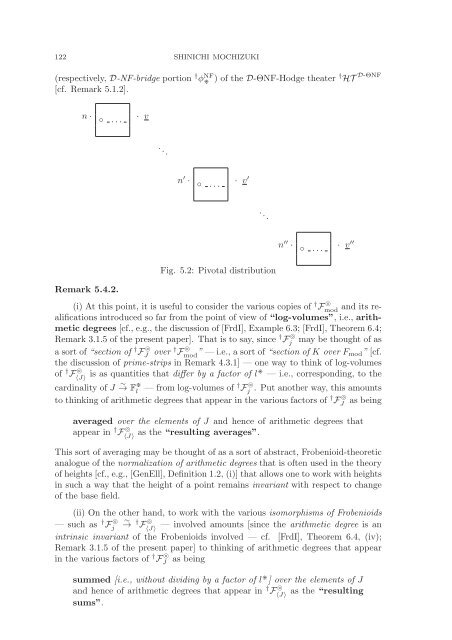Inter-universal Teichmuller Theory I: Construction of Hodge Theaters
Inter-universal Teichmuller Theory I: Construction of Hodge Theaters
Inter-universal Teichmuller Theory I: Construction of Hodge Theaters
Create successful ePaper yourself
Turn your PDF publications into a flip-book with our unique Google optimized e-Paper software.
122 SHINICHI MOCHIZUKI<br />
(respectively, D-NF-bridge portion † φ NF<br />
)<strong>of</strong>theD-ΘNF-<strong>Hodge</strong> theater † HT D-ΘNF<br />
[cf. Remark 5.1.2].<br />
n ·<br />
◦ ...<br />
· v<br />
. ..<br />
n ′ · ◦ ... · v ′ . ..<br />
n ′′ · ◦ ... · v ′′<br />
Fig. 5.2: Pivotal distribution<br />
Remark 5.4.2.<br />
(i) At this point, it is useful to consider the various copies <strong>of</strong> † F ⊚ mod<br />
and its realifications<br />
introduced so far from the point <strong>of</strong> view <strong>of</strong> “log-volumes”, i.e., arithmetic<br />
degrees [cf., e.g., the discussion <strong>of</strong> [FrdI], Example 6.3; [FrdI], Theorem 6.4;<br />
Remark 3.1.5 <strong>of</strong> the present paper]. That is to say, since † F ⊚ j may be thought <strong>of</strong> as<br />
a sort <strong>of</strong> “section <strong>of</strong> † F ⊚ J<br />
over † F ⊚ mod ” — i.e., a sort <strong>of</strong> “section <strong>of</strong> K over F mod” [cf.<br />
the discussion <strong>of</strong> prime-strips in Remark 4.3.1] — one way to think <strong>of</strong> log-volumes<br />
<strong>of</strong> † F ⊚ 〈J〉 is as quantities that differ by a factor <strong>of</strong> l — i.e., corresponding, to the<br />
cardinality <strong>of</strong> J → ∼ F l<br />
— from log-volumes <strong>of</strong> † F ⊚ j . Put another way, this amounts<br />
to thinking <strong>of</strong> arithmetic degrees that appear in the various factors <strong>of</strong> † F ⊚ J<br />
as being<br />
averaged over the elements <strong>of</strong> J and hence <strong>of</strong> arithmetic degrees that<br />
appear in † F ⊚ 〈J〉<br />
as the “resulting averages”.<br />
This sort <strong>of</strong> averaging may be thought <strong>of</strong> as a sort <strong>of</strong> abstract, Frobenioid-theoretic<br />
analogue <strong>of</strong> the normalization <strong>of</strong> arithmetic degrees that is <strong>of</strong>ten used in the theory<br />
<strong>of</strong> heights [cf., e.g., [GenEll], Definition 1.2, (i)] that allows one to work with heights<br />
in such a way that the height <strong>of</strong> a point remains invariant with respect to change<br />
<strong>of</strong> the base field.<br />
(ii) On the other hand, to work with the various isomorphisms <strong>of</strong> Frobenioids<br />
—suchas † F ⊚ ∼<br />
j → † F ⊚ 〈J〉<br />
— involved amounts [since the arithmetic degree is an<br />
intrinsic invariant <strong>of</strong> the Frobenioids involved — cf. [FrdI], Theorem 6.4, (iv);<br />
Remark 3.1.5 <strong>of</strong> the present paper] to thinking <strong>of</strong> arithmetic degrees that appear<br />
in the various factors <strong>of</strong> † F ⊚ J<br />
as being<br />
summed [i.e., without dividing by a factor <strong>of</strong> l ] over the elements <strong>of</strong> J<br />
and hence <strong>of</strong> arithmetic degrees that appear in † F ⊚ 〈J〉<br />
as the “resulting<br />
sums”.
















